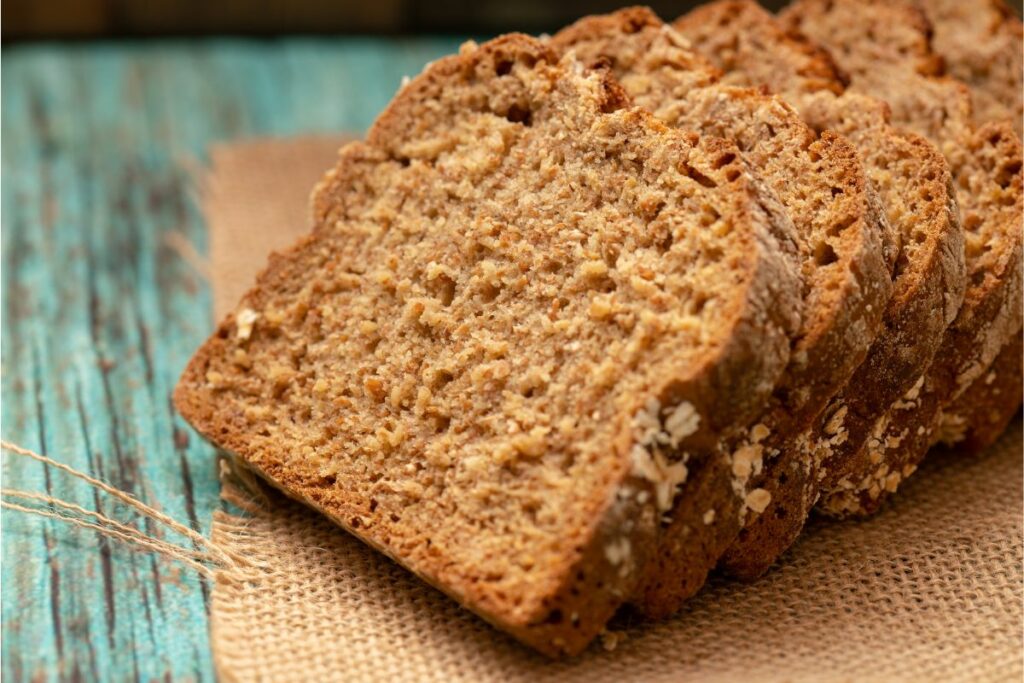Wholemeal, wholegrain, multigrain, wheat, rye, white, low FODMAP, low GI, and gluten free are all acceptable terms. How can we choose the bread that is greatest for our health when there are so many options?

This article will discuss the differences between different types of bread, including how wholegrain and whole wheat bread varieties are distinct so that you can discover which type of bread offers the most health benefits.
Which Is The Healthiest Bread?
In most homes, bread has long been a staple food. Wholegrain types are a wonderful protein source – high in fibre, vitamins, and minerals, along with healthy fats, and they are low in fat and a decent source of carbohydrates.
Dietary fibre, which is abundant in whole grains, keeps us feeling full. Wholegrain-rich diets have been associated to a lower risk of diseases like obesity, heart problems, type 2 diabetes, and several malignancies.
By reducing constipation and nourishing the “good” gut bacteria, fibre is also advantageous for bowel health and is expected to have a number of positive health effects.
According to a recent study, eating a lot of whole grains may reduce your risk of developing colon cancer.
White or wholemeal bread has a greater glycemic index (GI) than the wholegrain varieties due to the grinding of the grains during processing, which causes glucose to be delivered into the blood more quickly.
Regular intake of low glycemic index meals helps to control blood sugar levels, keeps us feeling full, and encourages us to eat less calories to maintain a healthy weight.
Wheat used to make white bread has had the bran and germ removed, limiting the amount of dietary fibre, B vitamins, vitamin E, and minerals including iron, zinc, magnesium, and phosphorus.
The Different Types Of Bread
White
White bread is harmful because it contains preservatives, salts, and sugars, as well as flour that has undergone extensive processing.
Consuming too much white bread can raise your chance of developing obesity, cardiovascular disease, etc.
White bread’s low fiber content can contribute to constipation in many persons. If you still decide to consume bread, learn why alternative varieties are preferable to white bread.
Wholemeal
Wholegrains are used to make wholemeal bread, which has a basic brown look and a fine texture.
Compared to white flour, whole-wheat flour has greater fiber. Although wholemeal bread has a greater GI than wholegrain breads, it also includes more minerals and vitamins than many types of white bread.
Multigrain
White flour and other grains are frequently used to make multigrain bread. However, compared to white bread, multigrain bread often has much more fiber as well as a lower GI, providing longer-lasting energy.
The bran, endosperm, and germ are all present in wholegrain bread.
Wholegrain
It is a good source of fiber, soluble, insoluble, and resistant starch, as well as carbs, protein, unsaturated (healthy) fats, vitamins, and minerals.

Bread made with whole grains and nuts has a hearty basis made of wholemeal flour. Find the phrase “whole grain” in the list of ingredients.
Healthy omega 3 fats are an added bonus in soy and linseed bread. Both wholegrain and wholemeal breads with additional grains have a low GI.
Rye
Rye bread (see also ‘Is Rye Bread Good For You?‘) is not gluten-free but has a thicker texture as a result of having less gluten.
Rye sourdough and wholegrain rye with additional grains both have lower GIs and greater fiber and vitamin contents than light rye. Rye is a healthy wholegrain option, and even pale rye is preferable than white.
Sourdough
Because of the higher level of acidity in sourdough bread, it has a lower GI.
The amount of fiber, vitamins, and minerals in the flour used varies – and wholegrain sourdough is by far the preferable option.
Make sure you buy a true sourdough because some contain yeast instead of the customary starter and are therefore fake.
Since it takes so long to make, real sourdough bread has an acidic, chewy texture, which lowers the GI.
Look for ingredients that have a chewy feel and don’t include any yeast, especially made with whole grains like rye wholemeal or wheat.
Fiber-Rich White
White breads with extra fiber are known as high-fiber white breads. For kids (or older kids) who won’t eat wholegrain bread, they are therefore a better option than conventional white bread.
Gluten-Free
To eliminate the wheat protein gluten, gluten-free breads are prepared from a grain other than wheat.
Although some now have additional seeds, historically gluten-free breads had less fiber and a greater GI than its wheat-containing counterparts.
These breads are helpful for those with coeliac disease or other forms of gluten intolerance, but they don’t provide any additional health advantages for the remainder of us over conventional bread.
Low FODMAP
Low FODMAP options have also just lately entered the market.
These loaves of bread are acceptable for persons who are sensitive to a class of carbohydrates known as FODMAPS, or those that have irritable bowel syndrome (IBS).
Wheat is one of the foods that contains FODMAPS (Check out this type of Khorasan wheat Here). For those with celiac disease, these loaves are still inedible because they contain gluten.
Wholegrain breads are generally preferable for those without sensitivities because they are healthier than standard white bread because they have seeds and grains, however the fiber level differs between brands.
Final Thoughts
Breads vary greatly from one another. Look for dense, hefty breads that contain lots of seeds and grains.
Food labels contain ingredients in descending order, so check for words like wholegrain, kibbled grain, nuts, and seeds at the top of the list.
According to the food standards code, foods that contain more than 4g of fiber per serve are good sources of fiber.
Choose a whole grain, rye whole grain, or real sourdough bread – especially grain sourdoughs and ryes (see also ‘Is Rye Bread Gluten Free?‘). The delicate fluffy white breads should be saved for special occasions.








